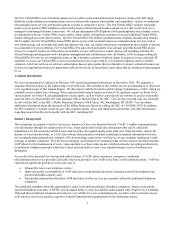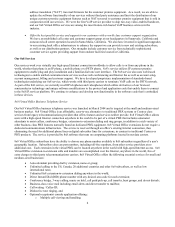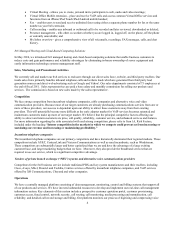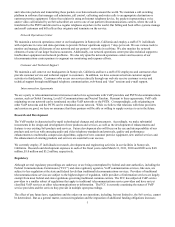8x8 2011 Annual Report Download - page 5
Download and view the complete annual report
Please find page 5 of the 2011 8x8 annual report below. You can navigate through the pages in the report by either clicking on the pages listed below, or by using the keyword search tool below to find specific information within the annual report.3
• They are expensive to build because each subscriber's telephone must be individually connected to the central office
switch, which is usually several miles away from a typical subscriber's location;
• They transmit data at very low rates and resolutions, making them poorly suited for delivering high-fidelity audio,
entertainment-quality video or other rich multimedia content;
• They use dedicated circuits for each telephone call which allot fixed bandwidth throughout the duration of each call,
whether or not voice is actually being transmitted, which is an inefficient use of the investment in the network; and
• They may experience difficulty in providing new or differentiated services or functions, such as video
communications, that the network was not originally designed to accommodate.
Until recently, traditional telephone companies have avoided the use of packet-switched networks for transmitting voice calls
due to the potential for poor sound quality attributable to latency issues (delays) and lost packets which can prevent real-time
transmission. Recent improvements in packet-switching technology, compression and broadband access technologies, as well
as improved hardware and provisioning techniques, have significantly improved the quality and usability of packet-switched
voice calls.
Historically, packet-switched networks were built mainly for carrying non real-time data, although they are now fully capable
of transmitting real time data. The advantages of such networks are their efficiency, flexibility and scalability. Bandwidth is
only consumed when needed. Networks can be built in a variety of configurations to suit the number of users, client/server
application requirements and desired availability of bandwidth, and many terminals can share the same connection to the
network. As a result, significantly more traffic can be transmitted over a packet-switched network, such as a home network or
the Internet, than a circuit-switched telephony network. Packet-switching technology allows service providers to converge
their traditionally separate voice and data networks and more efficiently utilize their networks by carrying voice, video,
facsimile and data traffic over the same network. The improved efficiency of packet switching technology creates network cost
savings that can be passed on to the consumer in the form of lower telephony rates.
The growth of the Internet in recent years has proven the scalability of these underlying packet-switched networks. As
broadband connectivity, including fiber lines, cable modem and digital subscriber line (or DSL), has become more available
and less expensive, it is now possible for service providers like 8x8 to offer voice and video services that run over these IP
networks to businesses and residential consumers. Providing such services has the potential to both substantially lower the cost
of telephone service and equipment to these customers and increase the breadth of features available to our subscribers.
Services like full-motion, two-way video are now supported by the bandwidth spectrum commonly available to broadband
customers.
Our Strategy
Our objective is to provide reliable, scalable, and profitable worldwide Internet-based communications services with
unmatched quality by leveraging our patented software technologies to deliver innovative, competitively priced offerings. We
foster an environment that empowers our employees to provide excellent service to our customers and partners at every point
of interaction. We intend to bring the best possible voice, video, unified communications, managed hosting and cloud-based
computing services at an affordable price to businesses and enhance the ways in which these customers communicate with each
other and the world. We intend to continue to focus our marketing primarily towards our business customer services.
Specific strategies to accomplish this objective include:
• Build an indirect sales channel. Our direct sales force generated more than 95% of our sales in 2011. In 2012, we
intend to build an indirect sales channel to expand distribution of our products and services. In February 2011,
we announced that Kim Niederman joined 8x8 as the Senior Vice President of Sales and Don Trimble joined 8x8
as the Vice President of Channel Sales. Between 2003 and 2007, Mr. Niederman was the Senior Vice President
of Worldwide Sales at Polycom, and Mr. Trimble was Vice President of North American Channel Sales at
Polycom between 2003 and 2008. We intend to leverage our commercial relationships with our equipment
vendors and the experience of these newly hired sales executives to market our services. In addition, we will be
engaging with other indirect sales channels to market our services.
• Capitalize on our technological expertise to introduce new products and features. Over the past 10 years, we
have developed or acquired several core technologies that form the backbone of our video and VoIP service
which we intend to use to develop product enhancements and future products. We developed the core software
associated with the Virtual Office product line including the call control engine, protocol stacks and network


















